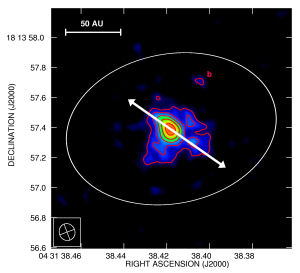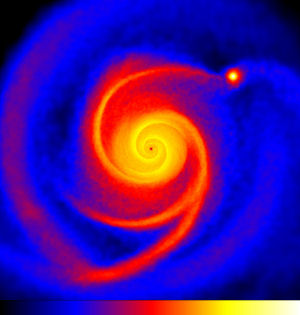Astronomers Find Embryonic Planet
2nd April 2008

Figure 1: The false colour image is a map of the radio emission (at a wavelength of 1.3 cm) emitted from the region around the star HL Tau. The candidate protoplanet is marked 'b'. The bar at top left (marked 50 AU) indicates 50 times the Earth-Sun distance on the same scale, or about the size of the orbit of Pluto. HL Tau is located in the centre of the image. The star is surrounded by a dusty disc tilted to the line of sight; only the inner part is visible here but its extent is indicated by the white ellipse. The arrows show the direction of the jets of hot gas emitted as 'overspill' from the star growth process. Image: VLA and Pie Town antenna.

Figure 2: This is an image from the computer simulation of HL Tau and its surrounding disk. In the model the dense clump (seen here at top right) forms with a mass of about 8 times that of Jupiter at a distance from the star about 75 times that from the Earth to the Sun. Image: Ken Rice / Royal Observatory Edinburgh
Movie File. Animation from the simulation showing the growth of the protoplanet in the disc around HL Tau. The total time is about 3000 years and shows the protoplanet forming at the edge of the disc, and then spiralling inwards to a distance about 75 times further from the central star than the Earth is from the Sun. Movie credit : Ken Rice
Using radio observatories in the UK and US and computer simulations, a team of astronomers have identified the youngest forming planet yet seen. Team leader Dr Jane Greaves of the University of St Andrews will discuss the 'protoplanet' in her talk at the RAS National Astronomy Meeting in Belfast on Wednesday 2 April 2008.
Taking advantage of a rare opportunity to use the Very Large Array (VLA) of radio telescopes in the US with the special addition of an extra telescope 50 km away, the team studied the disk of gas and rocky particles around the star HL Tau. This star is thought to be less than 100000 years old (by comparison the Sun is 4600 million years old) and lies in the direction of the constellation of Taurus at a distance of 520 light years. The disk around HL Tau is unusually massive and bright, which makes it an excellent place to search for signs of forming planets.
The VLA gives very sharp images of HL Tau and its surroundings. The team studied the system using radio emission at a wavelength of 1.3 cm, specifically chosen to search for the emission from super-large rocky particles about the size of pebbles. The presence of these pebbles is a clue that rocky material is beginning to clump together to form planets.
In the UK, scientists used the MERLIN array of radio telescopes centred on Jodrell Bank in Cheshire, to study the same system at longer wavelengths. This allowed the astronomers to confirm that the emission is from rocks and not from other sources such as hot gas. Jodrell Bank scientists Dr Anita Richards and Dr Tom Muxlow analysed the data.
The big surprise was that, as well as detecting super-large dust in the disk around HL Tau, an extra bright 'clump' was seen in the image. It confirms tentative 'nebulosity' reported a few years earlier at around the same position, by a team lead by Dr Jack Welch of the Berkeley-Illinois-Maryland Array. The new image shows the same system in much greater detail.
Dr Greaves comments, "We see a distinct orbiting ball of gas and dust, which is exactly how a very young protoplanet should look. In the future, we would expect this to condense out into a gas giant planet like a massive version of Jupiter. The protoplanet is about 14 times as massive as Jupiter and is about twice as far from HL Tau as Neptune is from our Sun."
Dr Richards adds, "The new object, designated HL Tau b, is the youngest planetary object ever seen and is just 1 percent as old as the young planet found in orbit around the star TW Hydrae that made the news last year. HL Tau b gives a unique view of how planets take shape, because the VLA image also shows the parent disk material from which it formed."
Team member Dr Ken Rice of the University of Edinburgh ran a computer simulation to find out how such a massive protoplanet could form. His animation shows a very similar body condensing out of a disk with similar properties to that actually observed around HL Tau. The planet forms because of gravitational instability in the disk, which is about half as massive as the star itself. This allows small regions to separate out and cool down into self-contained structures. This instability mechanism has been controversial, but the simulated and real data are such a good match that it seems the mechanism really does operate in nature.
Dr Rice comments, "The simulations were as realistic as we could make them and we were delighted that the results compare so well with the observations."
One intriguing property is that XZ Tau, another young star in the same region, may have passed near HL Tau about 1600 years ago. Although not required for planet formation, it is possible that this flyby 'tweaked' the disk and helped it become unstable. This would be a very recent event in astronomical terms. Whether the proto-planet formed in only the last few hundred years, or sometime in the 100000 years since the birth of HL Tau, the images provide a unique view of planet formation in action, and the first picture of a protoplanet still embedded in its birth material.
FURTHER INFORMATION
- Jodrell Bank Centre for Astrophysics
- University of St Andrews Astronomy Group
- Royal Observatory Edinburgh
- RAS National Astronomy Meeting
- RAS home page
- Science and Technology Facilities Council
NOTES FOR EDITORS
The VLA is operated by the National Radio Astronomy Observatory (USA) on behalf of United Universities, Inc.
MERLIN is operated by the University of Manchester, Jodrell Bank Observatory, on behalf of the Science and Technology Facilities Council (STFC).
The simulation ran on a supercomputer funded by the Scottish Universities Physics Alliance (SUPA).
The RAS National Astronomy Meeting (NAM 2008) is hosted by Queen's University Belfast. It is principally sponsored by the RAS and the Science and Technology Facilities Council (STFC). NAM 2008 is being held together with the UK Solar Physics (UKSP) and Magnetosphere, Ionosphere and Solar-Terrestrial (MIST) spring meetings.
CONTACTS
Dr Jane Greaves School of Physics and Astronomy University of St Andrews North Haugh St Andrews Fife KY16 9SS Scotland E-mail: jsg5@st-and.ac.uk Tel: +44 (0)1334 461681 Mobile: +44 (0)7864 741874 Dr Anita Richards Jodrell Bank Centre for Astrophysics Alan Turing Building University of Manchester Manchester M13 9PL U.K. E-mail: amsr@jb.man.ac.uk Tel: +44 (0)161 275 4124 Mobile: +44 (0)7766 065049 Dr Tom Muxlow MERLIN/VLBI National Facility Jodrell Bank Observatory Cheshire SK11 9DL U.K. E-mail: twbm@jb.man.ac.uk Tel: +44 (0)1477 571321 (switchboard) 572607 (direct line) Dr Ken Rice Institute for Astronomy University of Edinburgh Royal Observatory Blackford Hill Edinburgh Scotland EH9 3HJ E-mail: wkmr@roe.ac.uk Tel : +44 (0)131 668 8384


